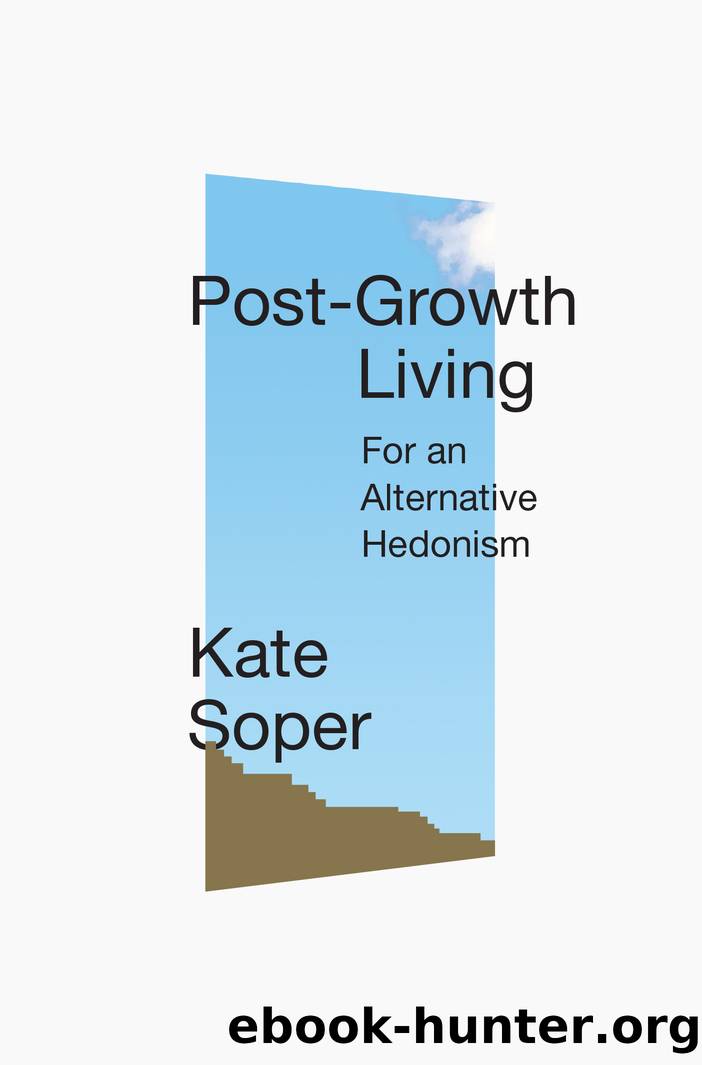Post-Growth Living by Kate Soper;

Author:Kate Soper;
Language: eng
Format: epub
Publisher: Lightning Source Inc. (Tier 1)
Urban design and policies are belatedly beginning to recognise something of this, with cities and towns in Europe and elsewhere introducing imaginative green changes in the use of space. In some cases, inhabitants as well as town planners are taking the initiative. In Seoul, for instance, a four-lane elevated expressway that between 1973 and 2003 took 170,000 vehicles a day into the city centre, has been demolished and replaced by a long riverside park with 1.5 million trees, a cycle way and a festival venue by the Cheonggyecheon river that was long buried under the road. Traffic chaos was predicted, but residents have adapted, with many more now travelling by subway. Buried rivers have also been restored in Seattle, New York and Sheffield.32 The Guardian recently featured images of a number of cities, including Addis Ababa, Bogota, Mumbai, and Sao Paulo and Fortalezza in Brazil, where drab and dangerous urban intersections had been transformed into colourful pedestrian-friendly areas.33 In Europe and Scandinavia, Freiburg im Breisgau has progressively pedestrianised since 1971, and is now largely car-free. Giethoorn in Holland, Nürnberg, Málaga, Seville, Siena and the Cinque Terre towns, Dubrovnik, St. Petersburg, Växjö, Malmö, and Copenhagen are among many other cities and towns that have become largely traffic free, at least in their old towns or more central areas. In Britain, some progress has been made in reclaiming streets from motor traffic and in some cases reducing speed limits, but it has not been remarkable, and the 20 m.p.h. limit is seldom policed and routinely ignored.
More exceptional, perhaps, are the changes that have recently come about in Doncaster, a working-class town surrounded by motorways and retail distribution centres, including a mammoth Amazon fulfillment centre on its outskirts. Doncaster is being reclaimed by councillors and local activists for a human-friendly âartisan economyâ. The former three-floor BHS store has become âFlip Outâ, a trampoline park; part of the town once dominated by a car park now houses a theatre and arts venue; and in 2020 a new âCultural and Learning Centreâ will open with a library and town museum. In the words of Rachel Horne, organiser of âCultural Crawlâ (in which cafés, pubs and other venues cooperatively host music, poetry and exhibitions), and co-editor of the new Duncopolitan whatâs-on magazine,
Weâre trying to create a different way of living. If I wasnât doing this, Iâd be clinically depressed, in a job that I hated â like a call centre. Thereâs not many other jobs here â so itâs like, âMake your own job.â ⦠Donny is a working-class town, but that doesnât mean weâre idiots. It doesnât mean weâre not really creative or that we canât have a stake in what happens in the town centre. You can see the hunger for doing something different thatâs here, if weâre just given the chance to make it happen. ⦠Call centres and warehouses are the modern pits. But it doesnât mean that those people in there arenât really creative. Itâs just a job. ⦠I donât really think we need the stuff we buy.
Download
This site does not store any files on its server. We only index and link to content provided by other sites. Please contact the content providers to delete copyright contents if any and email us, we'll remove relevant links or contents immediately.
The Bullet Journal Method by Ryder Carroll(1501)
Doesn't Hurt to Ask by Trey Gowdy(1399)
The Concise Laws of Human Nature by Robert Greene(1221)
The 7 Habits of Highly Effective People by Stephen R. Covey & Sean Covey(1013)
HBR's 10 Must Reads 2021 by unknow(975)
Hook Point: How to Stand Out in a 3-Second World by Brendan Kane(931)
HBR's 10 Must Reads 2021 by Harvard Business Review(877)
The Job Closer by Steve Dalton(819)
Master of One by Jordan Raynor(809)
Don't Sweat the Small Stuff...and It's All Small Stuff by Richard Carlson(808)
100 Things Successful People Do by Nigel Cumberland(799)
Primal Leadership by Daniel Goleman(778)
Amazon Unbound by Brad Stone(777)
Declutter Your Mind: A step by step guide to learn to control your thoughts, stop worrying, relieve anxiety and eliminate panic attacks and negative thinking by Mia Chandler(748)
Lives of the Stoics by Ryan Holiday & Stephen Hanselman(719)
Coders at Work: Reflections on the craft of programming by Peter Seibel(660)
The Power of 100! by Shaun King(643)
Conflicted by Ian Leslie(643)
The Mechanism of Mind by Edward De Bono(639)
